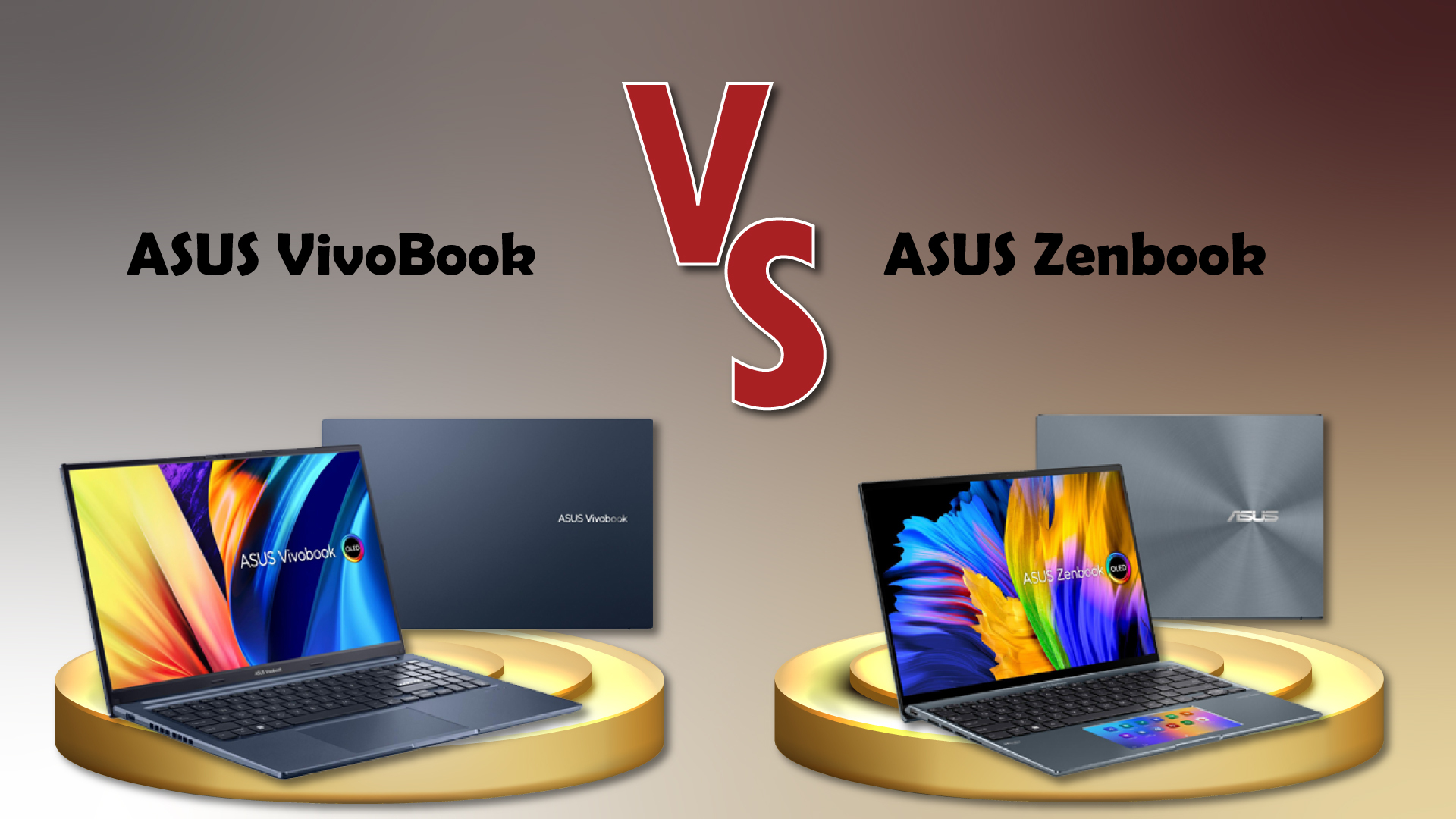ASUS was not as well-known for laptops, but now they’re famous for making laptops great for playing games and doing work. Two examples are the VivoBook M580VD-EB54 and the Zenbook Flip 14 UX463. These laptops can handle regular things like emails and documents, but they can also play games.
They can do this because they have potent parts, like a particular graphics unit that helps with games. Even though both laptops are good, one has a better deal because it offers more value for its price.
ASUS VivoBook vs. ZenBook Comparison
ASUS is known for its stylish yet simple laptop designs, and the VivoBook and Zenbook are no exception. Both laptops look attractive, with a sleek slate-gray color. The ASUS logo on their lids is a common feature that adds to their overall appeal.
When it comes to the build, both laptops are made from solid aluminum materials, giving them a sturdy feel. This similarity in build materials makes it hard to tell them apart at first glance. However, if you pay attention to the design details, you’ll notice a few differences.
One distinctive feature is the concentric circles on the Zenbook’s lid, giving it a unique touch. Another difference lies in their hinges. The VivoBook has a regular hinge, while the Zenbook boasts a unique 360-degree hinge that lets it transform into a tablet. This implies that the Zenbook can function as a laptop, a tent, a stand, or a tablet.
The Zenbook’s 2-in-1 design is excellent, but it does make the tablet mode a bit unwieldy due to its size. The Zenbook measures 320 x 206 x 17.9 mm and weighs 1400 grams, while the VivoBook is more extensive and heavier at 380 x 256 x 19.2 mm and 1990 grams.
Both laptops keep their design theme inside, with the same slate-gray color scheme. This consistency adds to their premium look. However, there’s a difference in the thick black borders around the displays. The Zenbook’s borders are thicker, but this is helpful in tablet mode, as they provide a comfortable grip without causing accidental actions.
Both laptops have Full HD screens with 1920 x 1280 resolution, LED backlighting, and a 16:9 aspect ratio. The Zenbook’s display stands out with its vibrant and bright images, thanks to its better contrast ratio of 1,346:1 compared to the vivobook’s 515:1. The Zenbook’s display also gets brighter at 300 nits, which is useful outdoors.
The Zenbook’s screen is also touch-sensitive, a bonus for its 2-in-1 design. ASUS even provides a stylus pen, making it feel like you’re writing on paper. However, be careful to place the pen correctly, as there’s no dedicated storage spot.
Typing on both laptops is comfortable, thanks to their well-spaced backlit keyboards. They both have touchpads that are slightly different in size, but they’re smooth and easy to use.
Inside, the VivoBook M580VD-EB54 has an Intel Core i5-7300HQ processor, while the Zenbook boasts an Intel Core i7-10510U processor. The Zenbook’s processor is faster, so it can handle more tasks simultaneously and run demanding programs smoothly.
Both laptops begin with 8 GB of memory and can be upgraded to 16 GB. The Zenbook’s memory is a bit older, but the vivobook’s memory is newer and might offer better performance. Remember, though, that a laptop’s performance depends on more than its memory type.
The VivoBook supports up to 256 GB of SSD for storage, while the Zenbook can go up to a roomier 1 T.B. Both laptops also have an S.D. card reader for easy storage expansion. The Zenbook’s storage is faster in benchmark tests to read and write files more quickly.
In visual elements, one has the freedom to select from various alternatives.The VivoBook can have Intel H.D. Graphics 630 or NVIDIA GeForce GTX 1050, while the Zenbook offers Intel UHD Graphics 620 or NVIDIA GeForce MX250. The Zenbook’s graphics are better, especially for games.
In tests, the Zenbook generally performed better than the VivoBook. However, in one test that measures graphics rendering, the VivoBook surprisingly did better.
Battery-wise, both laptops use similar 3-cell Li-ion batteries. The Zenbook’s battery is a bit bigger as shown in tests. The Zenbook lasted longer during web surfing, with around 7 hours and 41 minutes, while the VivoBook lasted about 6 hours and 32 minutes.
In summary, the Zenbook has some advantages over the VivoBook. Its 2-in-1 design, vibrant display, and longer battery life make it a better choice for versatility and performance.’
Conclusion
To sum it up, the ASUS VivoBook and Zenbook have unique qualities. The Zenbook has an excellent design that can turn into a tablet, and its screen looks excellent. It also works faster because of its better processor. Regarding pictures and games, the Zenbook is better because of its exceptional graphics. It can store more stuff too. Plus, its battery lasts longer when using the internet. Ultimately, the Zenbook is an excellent choice if you want something that looks good, works well, and lasts a long time on a single charge.


